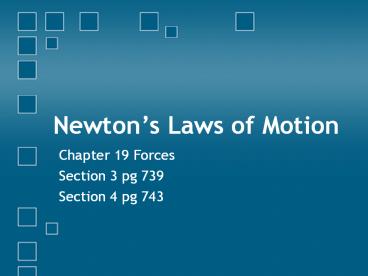Newton - PowerPoint PPT Presentation
1 / 15
Title:
Newton
Description:
Newton s Laws of Motion Chapter 19 Forces Section 3 pg 739 Section 4 pg 743 – PowerPoint PPT presentation
Number of Views:148
Avg rating:3.0/5.0
Title: Newton
1
Newtons Laws of Motion
- Chapter 19 Forces
- Section 3 pg 739
- Section 4 pg 743
2
Isaac Newton The force was with him"
- Born studied in England
- One of the most influential scientists of all
time - His discoveries of forces led to his credit of
the Newton.
3
Outline of Todays Lesson
- Main Idea Newtons Laws of Motion
- First Law of Motion
- Second Law of Motion
- Net Force Mass X Acceleration
- Third Law of Motion
- Review Notes
- Discuss Homework for next class
4
Newtons First Law of Motion
- Also known as The Law of Inertia
- Inertia has a 2 part definition
- Part I If an object is moving, then it will
continue to move until a force stops it. - Part II If an object is at rest, then it
will remain at rest until a force moves it.
5
How does mass effect inertia?
- Mass the amount of matter in an object. The
measure of mass does NOT change if gravity is not
present. - Greater Inertia
- The more mass an object has the harder it will
be to move or keep still. - Less Inertia
- The opposite is true If an object has less
mass, then it will be easier to move or keep
still.
6
While you look at this
- Ask yourself, which one has the greater mass?
The lesser mass? - Also, based on your guesses about mass, which one
has the greater inertia? Lesser inertia? - The strength of inertia is directly proportional
to the mass of the object. - In other words, what happens to mass also happens
to inertia.
7
Lets Review!
- Newtons First Law of Motion
- The more mass an object has, the more
inertia it will have - The less mass an object has, the less inertia
it will have
8
And now, a word from Jimmy Neutron on the topic
of Inertia
Remember objects with more mass are always harder
to keep still or keep moving! This affects how
much inertia an object has.
9
Newtons Second Law of Motion
- Main Idea of this Law Its a math problem
- Law States
- Net Force Mass X Acceleration
- Lets test out this formula
- Ex 1 What is the net force on a 1,000 kg object
accelerating at 3 m/s2? - 1 What formula will you use? NF M X A
- 2 Plug in the values. NF (1,000kg)(3 m/s2)
- 3 Solve! Net Force 3,000 Newtons
10
Lets try another example
- Ex 2 A car speeds up as it moves along the road.
If a force of 175 N is needed to make the car
accelerate to 25 m/s2. Whats the cars mass? - Formula Net Force Mass x Acceleration
- OR Mass Net Force / Acceleration
- Plug in your values Mass 175 N / 25 m/s2
- Divide and your answer is a MASS OF IS 7 kg
11
Lets try another
- Calculate the amount of acceleration needed to
move a 25 kilogram statue with a force of 75 N. - Formula Acceleration NF / Mass
- Plug in values A 75 N / 25 kg
- Divide and your answer is A 3 m/s2
12
What is cause and effect?
- Cause This means an action that happens
- Effect This is what happens as a reaction to the
cause - If your good friend beats you at video games,
then you will smack that person with the nearest
pillow. - In this case whats the cause? The effect?
13
- Newtons Third Law of Motion states that if one
object exerts a force on another object, then the
second object exerts a force of equal strength in
the opposite direction on the first object.
14
What????
15
Newtons Third Law of Motion
- For every action, there is an equal but opposite
reaction. - Forces react to each other in opposite ways.
- Thats why this law is cause and effect!































